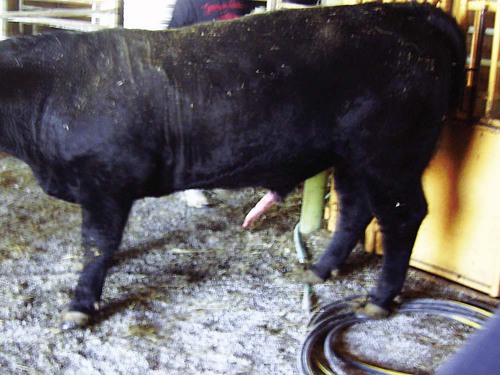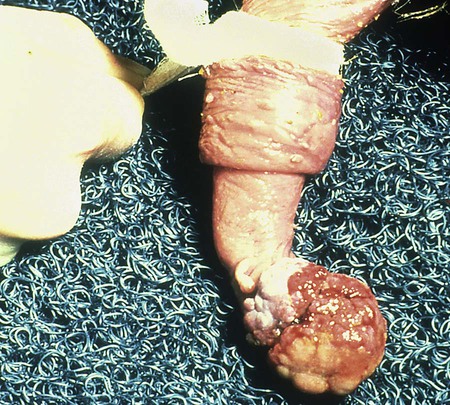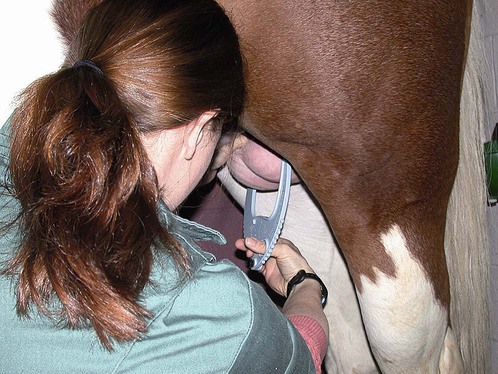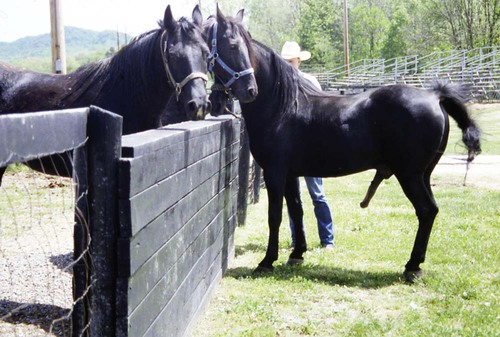After reading this chapter, you will be able to • Demonstrate understanding of the normal course of events in the reproductive process • Exhibit a knowledge of common selection methods used in large animal species • Demonstrate understanding of the importance of selecting superior livestock to be used in breeding programs • Understand and describe the components of a male reproductive examination • Understand the process of synchronization, the categories of drugs that can be used, and the advantages of using these procedures • Describe the importance of estrous cycle determination and how it can be achieved • Understand the importance of artificial insemination and embryo transfer • Describe different breeding systems • Understand the normal course of parturition and how to address dystocia • Selection of superior animals for breeding • Successful breeding, usually accomplished with estrous cycle determination and reproductive examinations • Successful conception using multiple breeding systems, embryo transfer, artificial insemination, and live cover • Successful implantation, which can be confirmed with use of pregnancy detection • Successful parturition, with addressing of any problems, such as dystocia, at the time of parturition When preparing EPD data, information is collected on the offspring produced from the male for which the EPDs are being developed. For example, birth weight, weaning weight, yearling weight, carcass data, ultrasound data, fertility, and scrotal circumference can be collected from the bull’s offspring. Scrotal circumference correlates with the amount of sperm-producing tissue and usually is a good indication of sperm production. The EPDs listed in Table 3-1 are not the only EPDs that can be measured; these are just a few of the most common. EPDs vary depending on the breed. TABLE 3-1 Example Estimated Progeny Differences for Two Bulls from the Same Breed Each EPD has an accuracy number associated with its value. The accuracy number (Acc) gives the producer an indication of the actual accuracy of the EPD. An accuracy close to 1.0 indicates higher reliability. Accuracy is affected by the number of progeny and ancestral records included in the analysis. The more progeny available for data collection, the greater the accuracy of the EPD (Table 3-1). The estrous cycle is broke into four phases: proestrus, estrus, metaestrus, and diestrus. Anestrus in livestock can be seen in seasonally polyestrous species and only in polyestrous species during pregnancy (Table 3-2). TABLE 3-2 Progesterone continues to be produced until the end of gestation if the animal is pregnant. If pregnancy does not take place, the body triggers a prostaglandin surge of PGF2α. The prostaglandin causes lysis of the corpus luteum, and progesterone begins to decline, which results in the transition from diestrus to proestrus (Fig. 3-1). Examination of the external genitalia must be done carefully to prevent injury to the examiner. Most males tend to resent handling of the genital areas. All males should be approached with caution and adequately restrained. The examiner is safest when positioned next to the animal’s chest. Standing next to the hindquarters should be avoided if possible; even heavily tranquilized animals can kick with the hindlimbs. In order to evaluate the penis, it must be extended from the prepuce. Some males allow manual extension by inserting a gloved hand into the prepuce and gently grasping the penis; however, this is uncommon. Most males must be tranquilized to relax the retractor penis muscle and allow the penis to extend. Rarely, after tranquilization, the penis remains extended for a prolonged period; this is more likely to occur when phenothiazine-based tranquilizers are used for tranquilization. Regardless of the drugs used, veterinary attention should be sought if extension persists for longer than 2 hours. Prolonged extension interferes with venous and lymphatic drainage of the prepuce and penis, resulting in rapid development of severe edema. Permanent damage to the penis (paralysis, paraphimosis, external trauma, priapism) may result if treatment is not instituted promptly (Box 3-1). The following parameters are evaluated during a male breeding examination. The prepuce is commonly referred to as the sheath in large animals. The ability to extend the penis, extension of the penis in a straight line, and skin lesions of the prepuce or glans penis should be evaluated (Fig. 3-2). The penis and prepuce are susceptible to a variety of benign and malignant tumors, parasitic lesions (habronemiasis), and other growths (Fig. 3-3). These lesions have no typical appearance; any abnormality is suspicious and best evaluated by a veterinarian. Visualization of the penis of bulls is usually done during the semen collection procedure. Rams are set up on their rump. The external preputial ring is pushed caudally and down toward the abdomen to reveal the glans penis, which is gently grasped with a gauze square and pulled into extension. Horses should be examined during penile cleaning. Many factors such as age, breed, and time of year can affect the scrotal circumference. Scrotal measuring tapes can be commercially obtained. Measurement is made by pulling the testicles fully into the scrotal sacs and measuring snugly around the largest circumference point (Figs. 3-4 and 3-5 and Table 3-3). TABLE 3-3 Expected Scrotal Circumferences Demonstrating breeding behavior is not always possible at the time of veterinary examination. Owners often must make these observations under natural conditions. The libido and mounting behavior of the male are observed. Intromission into the vagina and ejaculation should be confirmed (Fig. 3-6). Semen is collected using the procedures described in the following section. After collection, care must be taken to prevent temperature shock of the sperm, which can drastically affect the results of the semen evaluation. All surfaces contacted by the semen must be kept within the appropriate temperature range, from the semen collection container to the slides and microscope stage. This may require some planning, especially in cold climates. The collection bottle is taken rapidly to the laboratory for analysis. The container should not be shaken. It should be kept warm (37°C [98.6°F]) in an incubator or water bath and protected from ultraviolet light until it can be analyzed, which should be as soon as possible. Semen analysis is performed on the gel-free fraction of the ejaculate, which contains the majority of the spermatozoa. Many good references on semen analysis that detail the laboratory procedures and normal/abnormal parameters are available (Fig. 3-7). Box 3-2 outlines the characteristics generally included in a semen analysis.
Livestock Reproduction
The Importance of Reproduction
Selection
Estimated Progeny Differences
Bull Name
BW Acc
WW Acc
YW Acc
YH Acc
SC Acc
CEM Acc
Milk Acc
Marb Acc
Fat Acc
VT Pride
+4.4
.42
+40
.30
+60
.21
+.5
.16
–.62
.18
+8
.14
+20
.26
+.15
.14
+.026
.14
Wyatt’s Boy
+1.3
.98
+36
.97
+76
.96
+0
.96
–.55
.96
+7
.93
+16
.96
+.08
.87
–.023
.85

Reproductive Physiology
Hormone
Source
Female Target Tissue
Female Primary Action
Gonadotropin-releasing hormone (GnRH)
Hypothalamus
Anterior pituitary
Release FSH and LH from anterior pituitary gland
Luteinizing hormone (LH)
Anterior pituitary
Ovary (cells of theca interna and luteal cells)
Stimulates ovulation, corpus lutea formation, and progesterone secretion
Follicle-stimulating hormone (FSH)
Anterior pituitary
Ovary (granulosa cells)
Follicular development and estradiol synthesis
Estradiol (E2)
Granulosa cells of follicle
Hypothalamus, entire reproductive tract, mammary gland
Sexual behavior, GnRH, elevated secretory activity of entire tract, enhanced uterine motility
Progesterone (P4)
Corpus luteum
Uterine endometrium, mammary gland, myometrium, hypothalamus
Endometrial secretion, inhibits GnRH release, inhibits reproductive behavior, promotes maintenance of pregnancy
Prostaglandin F2α (PGF2α)
Uterine endometrium
Corpus luteum, uterine myometrium, ovulatory follicles
Luteolysis, promotes uterine tone and contraction, causing ovulation

Estrous Cycle and Hormone Involvement
Proestrus
Diestrus
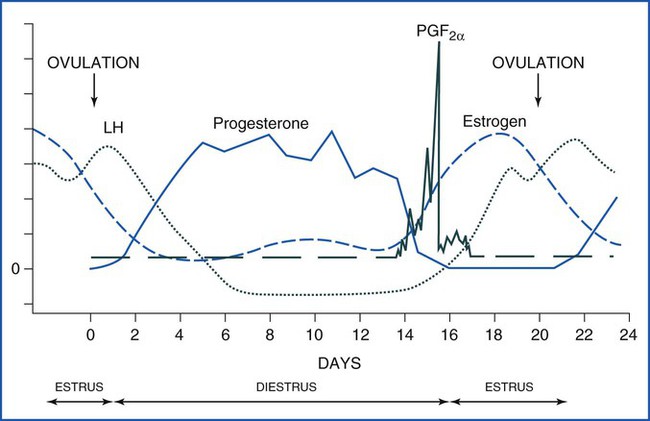
Breeding Soundness Examination
Prepuce and Penis
Measurement of Scrotal Circumference
Bull Age (months)
Size (cm)
12–14
30–34
15–20
31–36
21–30
32–38
≥31
34–39
Ram by Weight (kg)
Size (cm)
<45
23–27
45–70
27–33
70–90
30–36
90–115
31–37
115–135
33–38
135–160
36–40
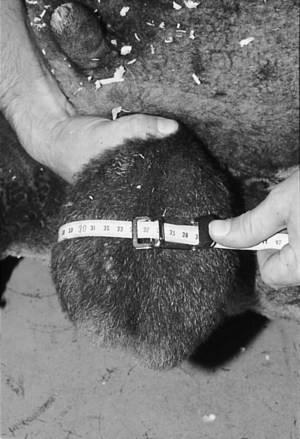
Breeding Behavior
Semen Analysis
Livestock Reproduction

